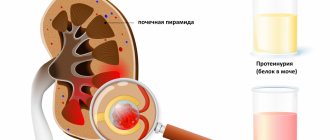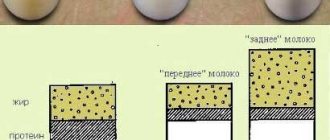When a child's temperature rises, a runny nose and cough begin, parents understand that it is most likely a cold. If your cheeks turn red or a rash appears, you may have an allergy. Well, the best way to tell about the state of a baby’s digestive system is his stool. But it’s not so easy to answer the question unequivocally of what a newborn’s stool should be like.
At birth, the newborn's intestines are cleared of meconium. These are sticky, odorless accumulations of black-green color, which indicate the normal functioning of the baby’s intestines. Afterwards, his stool depends on nutrition. We will tell you in the article what normal stool is like for a baby, why it comes in different colors and what “secrets” are hidden in a baby’s diaper.
The effect of food on baby's stool
from mother's milk changes color from dark green to golden green. This is a transitional feces, which is formed on the 3-5th day, until milk replaces colostrum. Afterwards, the stool is more uniform, acquires a yellow color, may have whitish lumps, and a faint smell of sour milk. It happens quite often. But we hasten to reassure parents: if the baby is gaining weight, then bowel movements after each feeding should not cause alarm. As the baby grows up, the stool will take shape and become denser and more regular.
Normal stool during breastfeeding:
- yellow, slightly greenish color;
- mushy consistency;
- sour smell;
- up to 6-10 bowel movements per day from birth, 1-2 times - closer to a year.
- greenish, yellowish-brownish;
- smear-like consistency;
- more pronounced odor;
- stool once every three days is also normal.
Normal stool color for a baby: shades of yellow, brown, green.
Feces on formula milk The less mixture in supplementary feeding, the yellower the stool. Babies who grow up on formula feeding have fewer bowel movements. And if there is no restless behavior, this indicates a high degree of nutritional absorption. Month after month, a child's stool will become more and more like an adult's stool.
Normal stool with artificial and mixed feeding:
From solid food, the stool changes even more towards the adult, it thickens and turns yellow-brown, but can take on the colors of the food that the child eats while the body adjusts to digesting new foods. Do not be afraid of introducing complementary foods; this is the norm for a cheerful and active baby. But we note the following: accumulations of white lumps of undigested food can “scream” about the introduction of complementary foods in too large volumes, which children’s digestion cannot completely cope with. But foamy, odorous stool with mucus already indicates that complementary feeding is started too early or that these products are not suitable.
How does complementary feeding affect a baby's stool?
- depending on the color of the food, the stool takes on different shades;
- the semi-liquid pulp becomes denser;
- possible increased colic, flatulence;
- vegetables usually cause loose stools, and cereals strengthen them.
An important point is that deviations from the usual frequency and appearance of stool do not always signal illness. And many parents have this experience. However, if changes worsen and new symptoms appear, please consult a doctor.
Colorless, black, blood-streaked stool, a lot of mucus and foam in the baby's stool - it is best to call an ambulance without waiting for a pediatrician's visit.
Reasons for changes in a small child's stool:
- insufficient maturity of the digestive organs, lack of enzymes;
- composition of food for a nursing woman;
- lack of breast milk;
- intolerance to infant formula, complementary foods;
- mother and child taking certain medications;
- physiological jaundice of the newborn;
- imbalance of intestinal microbiota;
- intestinal inflammation;
- viral, bacterial infections;
- food allergy.
Before the age of one year, green and yellow, looser or thicker stools can be either normal or pathological. Frequency and impurities that should not be in the stool of a healthy baby help to distinguish one condition from another.
When to worry and figure out what went wrong:
- white-gray or black stool;
- slurry mixed with mucus and blood;
- green watery stools with foam;
- bowel movements more than 12-15 times a day;
- rare stools: once every 3-5 days or less;
- completely liquid yellow stool with no solid particles;
- gagging in combination with diarrhea, fever;
- the child does not eat well, does not gain or loses weight;
- severe irritation and diaper rash in the diaper area;
- the child is uncommunicative, restless, and whiny.
Orange-white stool
In this case, one can suspect both a violation of the intestinal microflora and the fact that the baby’s mother has begun to eat large amounts of fatty foods. Also, a similar shade may indicate that the woman has started taking medications. When whitish, orange or yellow stool appears, many begin to suspect hepatitis. However, you need to understand that if there are no additional symptoms, then most likely there is no pathology. As a rule, with hepatitis, infants have orange, yellow, and light-colored feces. But in addition there will be severe pain in the abdominal cavity and vomiting. In this case, the urine usually darkens quite strongly and sharply.
Green stool in a newborn
Why a baby has green stools cannot be answered with certainty. Unnaturally green stools against the background of increased gas formation and a body rash can signal disturbances in the intestinal microflora and dysbacteriosis. Green, foamy stool in infants is often associated with lactose intolerance. Stools containing staphylococci and streptococci will also be green and foamy. When an infection occurs, the baby usually vomits, has a fever, and suffers from intestinal colic, and the first aid in this case will be an urgent medical examination. Medicinal mixtures and iron supplements also give the stool a greenish tint.
Why can a baby's stool be so rare?
Problems with stool in artificial infants may be due to the fact that the composition of their feces is close to that of an adult, and the intestines are not yet accustomed to such a volume and must be emptied approximately once every day or two. Less often - already constipation.
Breasts differ significantly in this regard. Nature prepares human milk from blood and lymph; it is almost completely absorbed by the child and is not “discarded.”
However! Stool retention can also be caused by Hirschsprung's disease. It occurs extremely rarely - in one in five thousand newborns, but it is important to remember. Therefore, if the baby is restless and has prolonged stool retention, you should consult a pediatrician to rule out this pathology.
Watch the course “Baby Colic: A Cheat Sheet for Mom” (free in ViLine.Club)
Causes of diarrhea in infants
Loose stools are not typical for healthy children, with the exception of newborns and infants of the second or third month. If at this age the child is calm, eats and sleeps well, and his weight gain is normal, then loose stools are not a cause for concern. Diarrhea can be caused by antibiotics, infectious diseases, early or excessive introduction of juices into the diet.
If diarrhea occurs during the introduction of a new product, then the product is canceled, and breastfeeding or artificial feeding is maintained. Alarming symptoms - apathy and drowsiness from dehydration, quiet and weak crying of the child - are beyond the norm and should be discussed with a doctor.
Advertising
Foamy stool
If a baby has yellow-orange stool with foam, then most often doctors diagnose functional disorders. Therefore, pathologies can be excluded. It is worth paying attention to the child’s behavior. If the baby is quite active and does not have any other alarming symptoms, then it is worth reviewing the mother’s diet. Perhaps the parents began to introduce new foods into complementary foods, to which a similar reaction appeared.
If the baby has the full set, that is, yellow-orange, greenish stool with mucus and foam, then this is a sign of malnutrition. This means that fermentation processes have begun in the child’s intestines. Therefore, both the nursing mother and the baby should stop eating raw vegetables (especially cabbage), carbonated drinks and eggs.
Causes of constipation in a newborn
Constipation in a newborn is often physiological; it occurs due to the immaturity of the digestive system and unformed reflex bowel movements. And it doesn't need to be treated. But if independent stool is absent for three days or more, the tummy is tense, the child pushes hard and cries, and has lost his appetite, then this is constipation, which is no longer the norm.
According to doctors, constipation from breast milk is rare, for example, when the baby is malnourished. This is also a typical condition on artificial nutrition, especially in the first ten days of introducing the formula, while the body adapts to foreign milk protein. However, thanks to the improvement of production technologies and the approximation of the contents of infant formula to the composition of breast milk, the stool of children on IV may be the same as that of breastfed children.
Orange lumps
If parents find orange spots in the baby’s stool that resemble cheesy lumps, then this means that the food is not completely digested. As a rule, this often happens in the first months of a baby’s life. His body has not yet had time to adapt to mother's milk, which has a high percentage of fat content.
Also, the appearance of such lumps may indicate that the child is overeating. Some food is simply not digested by the stomach. As a result, the undigested parts come out in the form of lumps. In this case, you should pay attention to the process of feeding the baby. If he is breastfeeding, then the baby loses more energy in the process, so overeating can be ruled out. But if the little one eats only from a bottle, then he spends less energy on it. Therefore, when feeding with artificial formula, you should be careful with portions. Then the baby’s bowel movements will improve.
How to normalize your baby's stool
In case of diarrhea, severe constipation, pathological inclusions in the stool, redness and microcracks around the baby's anus, it is important to contact a medical facility or call a doctor at home. You should not buy medications yourself to solve the problem. Even a regular enema, gas tube and suppositories for constipation are given for medical purposes.
You should also not try to change the mixture yourself - you may need nutritional therapy. When offering a mixture, the doctor expects a specific effect from it and takes into account the composition of the formula: microelements in forms digestible by infants, the presence of ingredients that improve intestinal microbiota and digestion, for example, milk fat, prebiotics and probiotics. MAMAKO® baby food made with goat milk meets these expectations. It is not suitable for children with a confirmed allergy to milk protein, but in general, the digestion process with goat milk is easier, which contributes to the formation of soft stools - the baby is in a good mood, is interested in toys, actively communicates, and sleeps peacefully.
On the MAMAKO® website, pediatricians talk about how newborn digestion works. There you can also download the “What’s in a baby’s diaper” leaflet.
Other reasons
It is quite possible that the baby’s orange stool comes from carrots, apricots, oranges and other foods that his mother eats. This diet contains large amounts of beta-carotene. But if the mother does not take any medications and is not particularly keen on fruits and vegetables of bright colors, then it is worth contacting a specialist. This is a rather alarming symptom.
Depending on the color saturation, the doctor can determine the stage of a particular disease. If the stool is orange, this may indicate that metabolic processes are occurring in the baby’s body. Therefore, it is important to undergo a timely examination. This means that you will have to take a stool test. A specialist should check its enzyme composition.
If, in addition to the appearance of orange stool, the child exhibits signs of intoxication, then it is necessary to immediately restore the water-salt balance and take measures to normalize the intestinal microflora.











